This material is based upon work supported by the National Science Foundation under Grant No. IIA-1301726.
2017 Graduate Student Poster Session
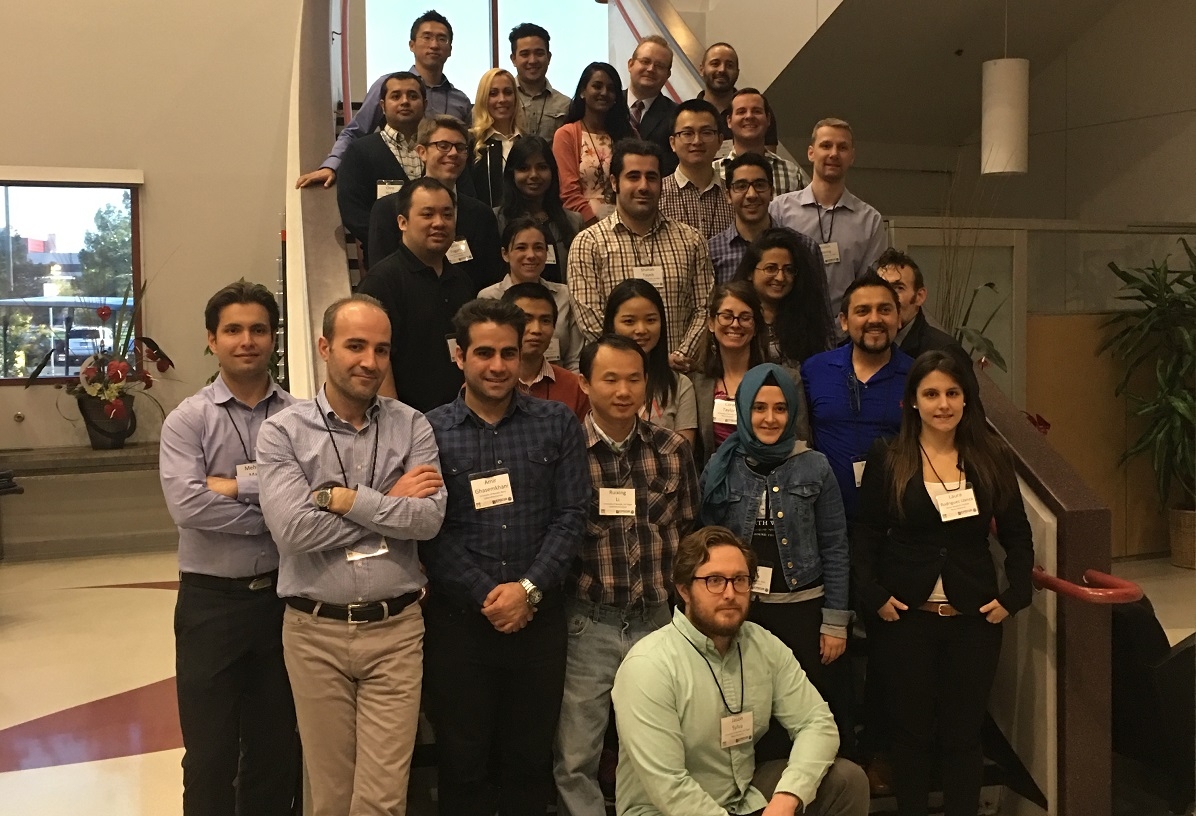

Ecological Impacts of a Utility-Scale Photovoltaic Panel Facility on a Creosote-Bursage Plant Community
Authors – Lorenzo Apodaca and Dale Devitt, University of Nevada, Las Vegas
Read Abstract
High energy demands and greater financial viability have propelled recent growth in the solar energy market. Southern Nevada is poised to become a major contributor of green energy through the commissioning of public and private lands for solar development, but there exists a pressing need to better understand the ecological consequences of these facilities as documentation of the impacts of large-scale solar operations on surrounding environments is severely lacking. The Copper Mountain 2 (CM2) solar facility in Eldorado Valley, Nevada, USA utilizes nearly 1.8 square kilometers of photovoltaic panels to generate enough energy to power about 50,000 homes and is situated within a predominately creosote (Larrea tridentata) and white bursage (Ambrosia dumosa) habitat. Currently, the potential impacts on the local environment related to this massive development are being studied from two perspectives: microclimate effects and alteration of surface hydrology. Overnight ambient air temperatures adjacent to the CM2 facility are elevated compared to temperatures recorded in undisturbed, native vegetation indicating the potential influence of a heat island effect. The largest heating effect occurred during the cooler months with a peak effect noticed in February (6.6 °C ± 0.78 SD versus 3.6 °C ± 0.85 SD), but this difference was not significant during the warmer months. Spatial heat maps are being generated to see examine the footprint of this heating effect as it extends out into the nearby native vegetation. Individual creosote and bursage plant physiologies are also being monitored to study any potential increase in plant stress influenced by the CM2 solar facility. A leaf xylem water potential gradient suggests that creosote plants growing closest to CM2 are under greater water stress than plants growing further away, but patterns in primary productivity, measured via stem elongation rates, show no clear gradient effect suggesting more complex controls on plant growth. Observations are still ongoing.
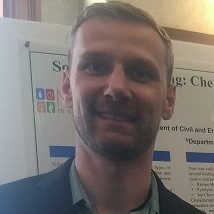
The Impact of Waters of Lesser Quality on Soiling Removal from Photovoltaic Panels
Authors – Alisson Boeing, Jason Sylva, Jacimaria Batista, and Spencer Steinberg; University of Nevada, Las Vegas
Read Abstract
This research examines the removal of soiling accumulated on solar panels using waters of lesser quality for panel washing. In addition, the chemical composition of the soiling is examined to correlate removed and remaining components with the type of water used and the degree or cleanliness achieved. A solar plant located at the West Yard of the City of Las Vegas, Nevada, has been set up with a monitoring system (i.e. weather station) and inverters to investigate the impact of waters of lesser quality on solar energy output. The set-up allows for the isolation of panels and their respective energy output. Soiling samples were collected directly from installed panels before and after washing and chemical analyses were performed to investigate the cleanliness potential of each method. The panels were grouped into six independent sections (about 10 KW array each) and each section was washed using different water types: Distilled water, treated wastewater with surfactant (Sodium Dodecyl Sulfate), treated wastewater, groundwater, and vacuum cleaner (no water – dry cleaning). One group of panels was left without cleaning (control). Panel soiling cleaning is performed manually using a soft cleaning brush. The amount of water utilized is 3 gallons for each group of panels. During cleaning, the water is collected in long containers placed along the panel and the resulting water is reutilized to wash the panels. A comparison of all cleaning methods will be performed using photovoltaic efficiency equations. The equations have been developed using the energy output, solar irradiance, and temperature. The panels are expected to be washed once per month. The cleaning efficiency of each water will be compared with the industry-standard deionized -water to verify if these types of water can be used in the future for soiling removal from PV panels.
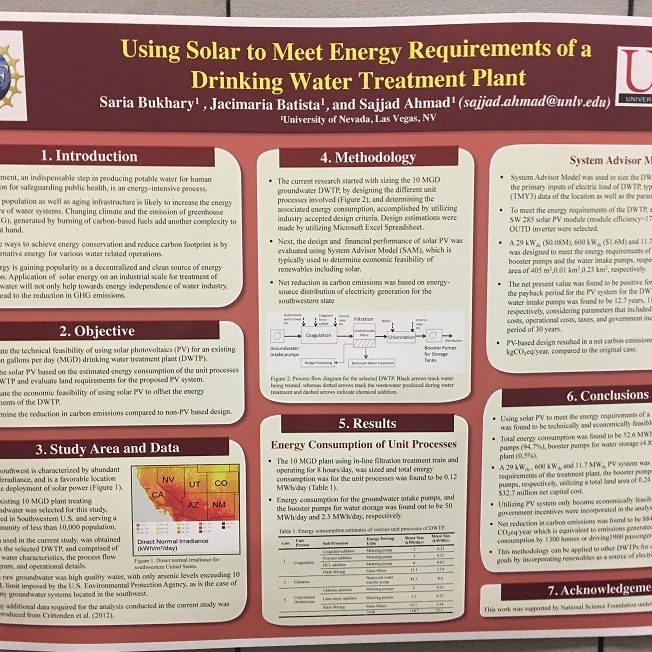
Using Solar to Meet Energy Requirements of a Drinking Water Treatment Plant
Authors – Saria Bukhary, Jacimaria Batista, and Sajjad Ahmad; University of Nevada, Las Vegas
Read Abstract
In recent times, there has been an increased emphasis on including sustainability into the water infrastructure design, for achieving both economic and environmental betterment. Potable water generation, which is vital for protection of public health, is an energy-intensive process. Carbon emissions caused by fossil-fuel based energy generation, as well as escalating energy costs warrant the use of renewables for generation of energy for treatment of drinking water. The objective of this study was to analyze the technical and economic feasibility of using distributed solar to fulfill the energy requirements of a 10 MGD drinking water treatment plant (DWTP), situated in the southwestern United States. The DWTP treated groundwater using in-line filtration treatment train that involved coagulation and filtration processes and employed chlorination for disinfection. Energy consumption was determined for each process using industry-accepted criteria. Based on the energy consumption of the DWTP and the existing land acreage, the DWTP was sized for distributed photovoltaics (PV) using System Advisor Model (SAM). Results showed that land availability was sufficient to meet PV deployment. Energy consumption for the water intake pumps, water treatment plant and the booster pumps for water storage was found out to be 50.1 MWh/day, 118.7 kWh/day and 2.6 MWh/day, respectively. A 28.8 kWdc, 777.5 kWdc and 15 MWdc PV system was designed to meet the energy requirements of the treatment plant, the booster pumps and the water intake pumps, respectively. PV-based design resulted in a net carbon emissions reduction of 2.4 million kgCO₂eq/day. For future work, this methodology can be applied to other DWTP for achieving sustainability goals by incorporating renewables as a source of electricity generation. This research contributes to objective 1 of nexus project.
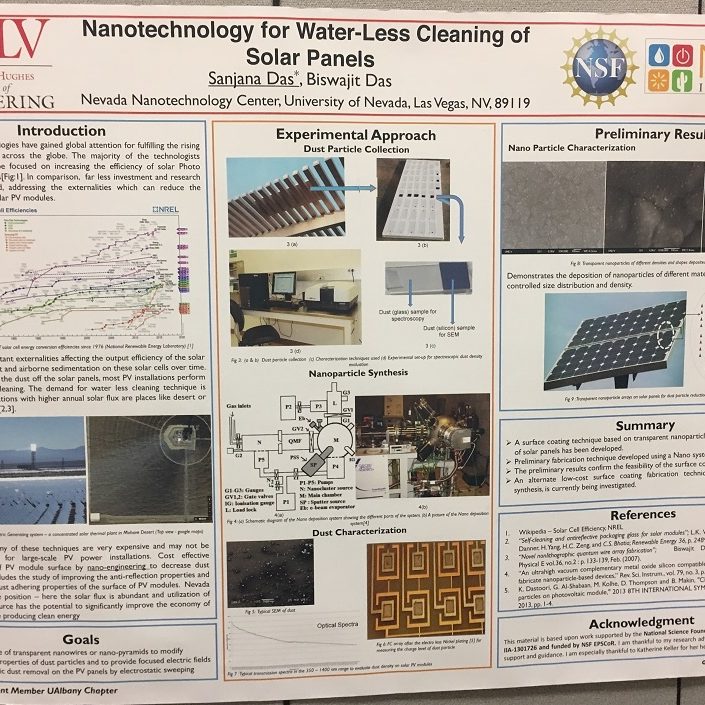
Nanotechnology for Water-Less Cleaning of Solar Panels
Authors – Sanjana Das and Biswajit Das; University of Nevada, Las Vegas
Read Abstract
Clean energy technologies are the present focus for fulfilling the rising demand for energy across the globe. Whereas vast majorities of researchers are working on increasing the efficiency, far less investment and research have been done in addressing the externalities that can be a setback for the technology deployment.
One of the very important externalities among them is dust and airborne sedimentation on the solar panels over time. In order to clean the dust off the solar panels, most Photo Voltaic (PV) installations perform periodic water cleaning. However, as locations with higher annual solar flux are usually arid, there is a strong demand for water-less cleaning of solar panels. While some water-less cleaning technologies currently exist, primarily based on NASA’s lunar and mars expeditions, most of these techniques are expensive and not cost effective for large-scale PV power generation.
We are currently using nanotechnology to develop a process for the water-free cleaning of solar panels, which we believe will be cost-effective for large scale PV generation. The technology involves the use of arrays of transparent nanoparticles deposited on the solar panels using a low cost technique. The nanostructure arrays provide focused electric field to modify the electrical properties of the dust particles; the charged dust particles are then removed by electrostatic sweeping.

A Remote Sensing Study of the Land Surface Temperature Effects of Utility-Scale Solar Energy Plants
Authors – Mohammad Masih Edalat and Haroon Stephen; University of Nevada, Las Vegas
Read Abstract
Solar plants are designed to absorb sun’s energy, which can change energy balance in a region. Thus, a potential effect of solar plants is thermal effect that can influence ecosystem and the environment. In the United States, high solar insolation levels in the Southwestern states creates significant electricity generation potential and thus subsequent impact on local and regional environment. The current operating solar plants generate 15 gigawatt electricity while the plants that are under construction and development are going to generates 43 gigawatt. Thus, it is expected to see more solar plants appearing on the southwest US landscape in the near future.
In this study, the thermal effects of utility-scale solar energy (USSE) plants are studied by analysis of land surface temperature (LST) with a particular comparison of pre- and post-installation conditions. The objective is to determine the significance of LST trends due to USSE construction. LST is obtained from brightness temperature obtained by Landsat 5 TM and Landsat 8 TIRS. This study is conducted at Copper Mountain Solar 1 located in Nevada. Since LST varies daily and seasonally, data treatment techniques are used to remove temperature variation in the data. The Man-Kendall test is applied to determine the significance of trends in resulting LST. Solar panel shadow can play in important role in the resulting average temperature. Therefore, a proportion of shadow in pixels casted by panels is estimated by analyzing sun angles for different times of year. The results showed that LST significantly decreases inside the plant area in winters and does not change in summers due to the panels’ shade on the ground. The satellite based observations used in this analysis are collected at 10AM. This trend analysis shows that USSE plants do not significantly effect LST in the surrounding environment at this particular time of day.
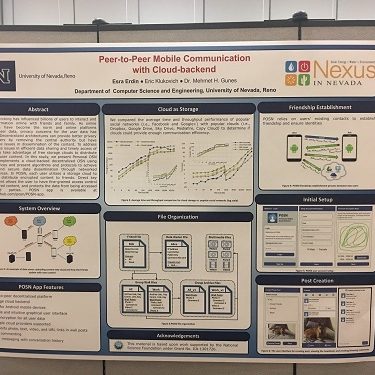
POSN: A Privacy Preserving Decentralized Social Network App for Mobile Devices
Authors – Esra Erdin, Eric Klukovich, and Mehmet H. Gunes; University of Nevada, Reno
Read Abstract
Social networking has influenced billions of users to interact and share information online with friends and family. As online interactions have become the norm and online platforms amassed user data, privacy concerns for the user data has increased. Decentralized architectures can provide better privacy to the users by removing the central authority but have performance issues in dissemination of the content. To address performance issues in efficient data sharing and timely access of objects, we take advantage of free storage clouds to distribute encrypted user content. In this study, we present Personal OSN app that implements a cloud-backed decentralized OSN using mobile devices and present algorithms and protocols to achieve efficient and secure data dissemination through networked mobile devices. In POSN, each user utilizes a storage cloud to store and distribute encrypted content to friends. Direct key management allows the user to have fine-grained access control of the shared content, and protects the data from being accessed by third parties. POSN app is available at https://github.com/posn/POSN-app.
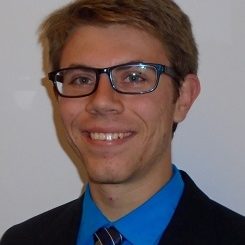
Measuring Public Attitudes Towards Residential Rooftop Solar Policies
Authors – Brian Fogarty, Dilek Uz, and Thomas Harris; University of Nevada, Reno
Read Abstract
Nevada and many other states have recently been undergoing dramatic shifts to their net metering policies, causing political and economic debates across the country. The changes to the policies have come under scrutiny from the public and from solar advocacy groups, while Public Utilities Commissions and regulatory bodies have defended their decisions, citing the potential cost shifting between different customer groups. The cost shifting is believed to exist between solar rooftop customers and the rest of the utility customers which can potentially raise the price of electricity for everyone. Despite some of the decisions have been widely protested by the rooftop solar owners, general public’s opinion on this issue is largely unknown. For example, it might have been an underlying factor which influenced the overwhelming vote for Nevada Ballot Measure #3. This event is not confined to Nevada, across the United States there has been a general trend of net metering policy being rolled back and the public fighting back.
A public opinion survey is in the process of being distributed to quantify the gap between the goals and priorities of the utilities, the Public Utilities Commissions, and the general public. The survey will help complement results from ongoing research on the net metering information, advanced metering infrastructure, solar energy potential, electricity prices, and electricity intensity for each state.
Using Amazon’s Mechanical Turk website, the survey will be distributed to a random selection of individuals across the United States. The results will help fill the void of knowledge that currently exists regarding the public’s views towards cost shifting.
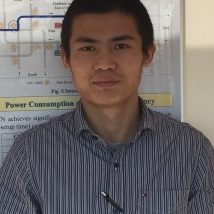
Snow Detection Using Machine Learning Method on Southern Nevada Research Cloud
Authors – Zhao Fu, Mei Yang, and Yingtao Jiang; University of Nevada, Las Vegas
Read Abstract
To meet the higher requirements of large datasets processing, storage, and security in Nexus research, our group has developed a scalable cloud computing platform, namely Southern Nevada Research Cloud (SNRC). On SNRC, the state-of-the-art research software, including OpenStack, Spark, Hadoop, Jupyter Notebook, Python, Octave and R, have been deployed. In this poster, a snow detection demo based on the data from Nevada Research Data Center will be presented to demonstrate the data processing capability and high performance of SNRC. The images of the same location taken at different time points will be processed using the machine learning tools available in SNRC. A two-layer neural network model will be developed which can process several hundreds of images in only two minutes. This neural network model can be expanded to solve other similar problems.

Long Term Recovery of Creosote Bush and Blackbrush Shrublands Following Disturbance in the Mojave
Authors – Dominic Gentilcore and Scott Abella; University of Nevada, Las Vegas
Read Abstract
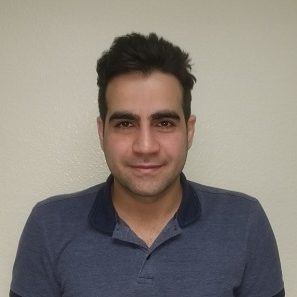
Reinforcement Learning Based Pricing for Demand Response
Authors – Amir Ghasemkhani and Lei Yang; University of Nevada, Reno
Read Abstract
Smart pricing based demand response (DR) programs can enable the system to shape load profiles to improve system reliability and performance. Existing works on pricing based DR often assume assumption that users’ response functions are available or predictable at the LSE side. However, it is challenging to have all users’ response functions, which also exhibit random behaviors due to serious privacy concerns of users. Clearly, any mischaracterization of users’ responses would result in higher system costs. To tackle this challenge, we leverage reinforcement learning to learn users’ response function. Specifically, we formulate the DR problem as a stochastic optimization problem, in which a random response is considered to model
the users’ unpredictable behaviors. We develop a reinforcement learning based algorithm to solve a pricing strategy for DR without assuming any specific forms of users’ response functions. The proposed reinforcement learning algorithm is shown to converge to an equilibrium with nearly optimal performance, which is corroborated via numerical simulations.

On Conditional Summertime Day-Ahead Solar Irradiance Forecasting: Development Beyond Numerical Weather Prediction Models
Authors – Marco Giordano, John Mejia, and Eric Wilcox; University of Nevada, Reno and Desert Research Institute
Read Abstract
We have investigated the accuracy of numerical weather prediction (NWP)-based global horizontal irradiance (GHI), and clear-sky index forecasting over southern Nevada. Accurate forecasts of solar irradiance are required for electric utilities to economically integrate substantial amounts of solar power into their power generation portfolios. Daytime cloudiness decreases received solar irradiance, and hence decreases phtovoltaic collection and its ensuing solar collection array output. Solar irradiance forecasting can enhance the value of renewable energy by anticipating fluctuations in these variable resources. In the Las Vegas/ southern Nevada region, summertime cloud variability depends largely on the combination of tropical and extratropical synoptic-scale forcings, most of which are observable, predictable, and highly related to the North American Monsoon moisture surge events. We used high-resolution realtime NWP output, based on the weather and research forecasting (WRF) mode, to study the ability of the model to deliver day-ahead GHI and clear-sky index forecasts for a the National Renewable Energy Laboratory (NREL)-University of Nevada site, located in Las Vegas, Nevada. Forecast products were obtained from the Desert Research Institute (DRI) Weather Intelligence and Numerical Decision Support (WINDS) archived forecasts. Results showed the importance of developing a seasonal and weather-dependent model output statistics (MOS) approach to improving forecast accuracy. This approach removed the previously observed ground site measurement bias, and reduced the overall relative root-mean –square error (rRMSE) of GHI by as much as 6%, when compared to the uncorrected model output. Improved forecast accuracy was obtained at the expense of providing additional information that relates regional-scale processes driving cloudiness and irradiance variability to the target area. We showed the seasonal dependency of the NWP forecast accuracy and implementation of intelligent weather functions as research and operational opportunitites to improve accuracy of post-processing strategies even further.
In our companion study making use of an external variable in correlating predicted GHI to ground-recieved (measured) values which are related to regional-scale cloud generating processes, we examined the viability of using a geostationary satellite derived quantity – clear-sky infrared brightness temperature, as an indicator of the local “cloudiness” condition. We specifically made use of the NOAA’s GOES West (Geostationary Operational Environmental Satellite) Infrared Channel 4 (IR04) having a 10.7 micron centered wavelength dependence – which is normally devoid of atmospheric attenuation (a “window” region), and recorded every 15 miuntes throughout the day. [Data is available through the NESDIS National Environmental Satellite Data and Information Service online portal]. Pixels from the GOES images were redacted to match those above the ground footprint having a radius of ~ 11.2 km centered on the coordinates of the Las Vegas NREL radiometer location. We made use of both GOES IR Tbrightness, and NREL GHI during a period from 01.01.2015 though 11.01.2016. The data was combined into a single set by selecting only the nearest matching time coincident GOES records to within +/- one minute of the coincident ground-based NREL record. Studies using a simple set of descriptive measures – TB minimum,TB maximum, TB average and the TB standard deviation, (from the pixel set) showed trends in satellite retreived cloud-top temperatures do indicate episodes of local cloudiness, and may be used as indicators/predictors of the onset transition into, and transition out of cloudy conditions (proxy for reduced GHI). The added information from geostationary satellite retrievals can be used to enhance NWP forecasts of GHI, and should be considered in deeper detail through future studies incorporating the recently launched GOES-R data, as it becomes available with data products of greater spatial and temporal resolution.
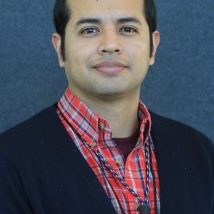
Improved Islanded Operation of a Diesel Generator – PV Microgrid with an Advanced Inverter
Authors – Chris Hicks and Yahia Baghzouz; University of Nevada, Las Vegas
Read Abstract
This poster describes the steady-state and dynamic operation of a stand-alone (islanded) microgrid that is powered by a diesel generator and a PV system that uses an advanced inverter. Experiments show that voltage and/or frequency deviations due to sudden changes in demand can result in poor power quality and reliability. Activating some of the autonomous functions of the advanced inverter (i.e., soft-start and OV/UV and OF/UF ride through) are shown to be capable of improving the power quality and service continuity.

Examination of CSP Absorber Coating Material Techniques for High Temperature Durability and Anti-Reflective Capabilities
Authors – Cilla Jose, Dale E. Karas, Samuel Tam, and Jaeyun Moon; University of Nevada, Las Vegas
Read Abstract
Concentrated solar power (CSP) has been known to as a considerable and widely used renewable energy resource. However, in order to compete with other renewable energies in the market, the energy retained CSP must be utilized so that it is cost-effective and efficiently run. I will be particularly focusing on the CSP coating materials that are line the heliostats and are the first recipients of the sun’s solar energy in a CSP system. The cost-effectiveness and efficiency is will be conducted in three steps. The first step will be examining the most cost-effective approach to their material deposition. I will testing out a variety of techniques such as plasma spraying, powder coating, Anilox coating, etc., to see which one will allow the absorber material to absorb as much light energy as possible. The second step is to insure that the CSP absorber coating materials are spectrally-selective. CSP absorb radiant energy in the ultraviolet and visible spectra while emitting in the infrared, correlating to reduced waste heat loss. Since many CSP experiments are concerned with a high absorbance and low emittance rate, it would be useful to find a coating that has anti-reflective properties, similar to that of spectacles. This coating would be needed to be tested for its durability in the midst of the sensationally high temperatures that CSP is exposed to. The third step is ensuring that the materials operate at very high temperature. For my research, I would like to propose using a consistent nanoparticle matter, such as mixture of cobalt oxide and other metal oxides, as the nanoparticle material has been known to remain intact even after exposure to 750°C for long periods of time. Repeatedly testing this material to see what type of coating process allows the material to perform at the most optimal levels is something I would like to invest in researching.
Concentrated solar power (CSP) platforms is enabled through higher temperature operation, maximizing electric power output from solar thermal energy conversion. One significant technology for reliable high-temperature operation has been the implementation of high temperature durable spectrally-selective solar absorber coatings – they can absorb ultraviolet, visible, and near-infrared solar irradiation while limiting spontaneous thermal radiation from emittance at higher wavelengths. For this project, metal-oxide solar absorber coatings have been investigated for high temperature CSP energy conversion, as it aims to develop low-cost, energy-efficient syntheses for larger-scale implementation. Implications for environmental, economic, and biological impacts will also be considered.
The Energy & Environmental Materials Laboratory at The University of Nevada, Las Vegas (UNLV) is currently investigating variant metal-oxide materials that can be utilized to efficiently absorb solar thermal energy leading to enhanced CSP system efficiency. Succeeding metrological analyses including Field-Emission Scanning Electron Microscopy (FESEM) with Energy Dispersive Spectroscopy (EDS) quantification, X-Ray Diffraction (XRD), and profilometry, our development of metal-oxide solar absorber coatings is characterized through spectroscopic measurements (FTIR & scan monochromatic) on an optical testbench to identify spectral absorptive response, inherently classifying new materials and their feasibility for energy-efficient solar absorber coaters.

Copper-Oxide Spinel Absorber Coatings for High-Temperature Concentrated Solar Power Systems
Authors – Dale E. Karas and Jaeyun Moon; University of Nevada, Las Vegas
Read Abstract
Concentrated Solar Power (CSP), in comparison to photovoltaic solar panels, involve methods to concentrate the sun’s energy onto receiver systems that generate steam, activate turbines, and consequently generate electrical power. To achieve cost-effective power generation, CSP implementation in solar-favorable geographic areas provides a competitive avenue in the market for energy production; additionally, the technology features storable energy at times of limited or null solar irradiance, higher energy conversion potential, and the ability to retrofit older nonrenewable-based power plant installations for a reduced environmental footprint. One significant technology for reliable high-temperature operation has been the application of durable solar absorber coatings on CSP receiver systems, using materials that favor ultraviolet, visible, and near-infrared solar irradiation responsivity while limiting spontaneous thermal radiation from emittance at higher wavelengths, correlating to a reduction of undesirable energy loss through waste heat. In this work, black metal-oxide nanoparticles comprising copper cobalt oxides (Cu[x]Co[3-x]O4) and copper manganese oxides (Cu[x]Mn[3-x]O4) are synthesized for solar absorber coating potential by hydrothermal syntheses, selected for low-cost, energy-efficient fabrication capable for bulk manufacturability in contrast to sol-gel and dip-coating methods. The material is deposited onto high-temperature, durable Inconel substrates by a flexible spray-coating method, and characterization is performed by SEM, EDS, and XRD analyses, as well as measurements to gauge thermal performance. The solar receiver performance and high temperature stability are accessed by comparing spectral reflectance and the figure of merit (FOM) before and after high temperature exposure. In addition to extending metrological and materials analyses, computational routines for optical simulations are discussed, regarding the feasibility for the energy-efficient solar absorber coaters presented in this work. This study ultimately showcases produced materials with high figure-of-merit conversion efficiency, demonstrating solar absorber coatings capable of interfacing with CSP receiver systems.

Computational and Experimental Investigation of Air Cooled Steam Condensers
Authors – Kaipo Kekaula, Yitung Chen, and Robert Boehm; University of Nevada, Las Vegas
Read Abstract
Increased energy demand stemming from growing populations coupled with limited water resources has lead to substantial research in reducing water consumption in power plants operating on Rankine cycles. Air-cooled steam condensers (ACSCs) can significantly lower water requirements in these systems by using ambient air in its place as the cooling fluid but are not commonly implemented due to comparatively high capital costs and decreased overall system performance. A comprehensive computational model and experimental system are developed to simulate prevailing heat and mass transfer phenomena in an effort to evaluate performance augmentations including enhanced surfaces, geometric modifications and operating condition optimization.
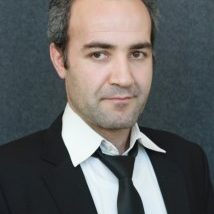
Anomaly Classification for Power Networks Using a Quotient Gradient System
Authors – Hamid Khodabandehlou and Sami Fadali; University of Nevada, Reno
Read Abstract
The classification of anomalies or sudden changes in power networks is essential to take the appropriate action that guarantees the quality of power delivery. This issue has increased in importance with the proliferation of renewable energy sources such as solar power. In this study, we use the quotient gradient system (QGS) for anomaly classification in power distribution networks. QGS is a systematic method for finding solutions of constraint satisfaction problems. QGS searches for the local minima of the optimization problem using the trajectories of a nonlinear dynamical system. We transform the measurement data from the power network into a constraint satisfaction problem and use QGS to solve the resulting optimization problem. Simulation results show that the proposed methodology can reliably distinguish between different anomalies in distribution networks.
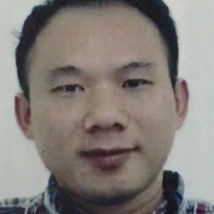
Improving Subpixel Target Detection Using Hybrid Detection Space
Authors – Ruixing Li and Shahram Latifi; University of Nevada, Las Vegas
Read Abstract
We describe a hybrid method for subpixel target detection using hyperspectral imaging. Hyperspectral images have high spectral resolution and low spatial resolution. Therefore, most targets exist as subpixel in the image, and this would place challenges in target detection. We use the scores of CEM and ACE algorithm to construct a hybrid detection space. First, one random reference target spectral is extracted from the scene to perform first time detection to determine the target and background subspaces. Then a new reference target spectral is extracted from the target subspace to perform a second time detection in order to minimize the effects of target spectral variation. Furthermore, target free background covariance matrix is estimated by the background subspace and then the subpixel distribution in the detection space is evaluated to improve the detection performance. Two synthetic datasets and one real dataset is used in the experiment. The results are evaluated based on the mean detection rate of ROC curve. Compared to the individual CEM and ACE algorithms, the new method is shown to have better performance on all three datasets. This method can be applied in remote water resource detection and contamination detection to search for extreme small target distribution in a large scene, and therefore, it is aligned with the general objective of the NEXUS project.
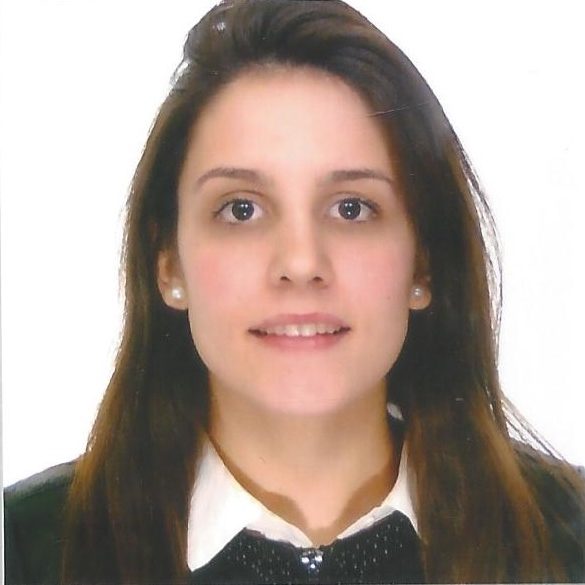
Degradation of Photovoltaic Solar Energy Production Due to Deposition of Absorbing and Non-Absorbing Mineral Dust
Authors – Laura R. Llanza, Patricio Piedra, and Hansmüller; Desert Research Institute
Read Abstract
Grid connected solar energy production has been growing rapidly in recent years. However, the efficiency of photovoltaic cells decreases when mineral dust deposits on solar cells. One needs to be able to predict this efficiency decrease as part of solar forecasting, as needed for efficient grid operation. In this study, we deposit incremental amounts of mineralogically pure absorbing (e.g., hematite) and non-absorbing (e.g., an off-white lakebed deposit, containing mostly diatoms, plagioclase, and quartz) dust particles on glass slides, which act as surrogates for solar cells. We measured forward hemispheric light transmission and backward hemispheric reflection spectra of our dust-deposited glass samples using a spherically integrating spectrophotometer. From these measurements, we derive absorption and forward and backward scattering optical depth spectra as function of deposited mass density. While forward scattering still contributes to solar energy production, absorbed and backward scattered light does not. We expect our measurements to be compatible with the exponential behavior described by Beer’s law with further analysis including optical particle properties such as asymmetry parameter and scattering albedo. This study has the potential to explain and forecast solar cell degradation as function of particle size, complex refractive index, and optical depth as needed for solar forecasting to include effects of mineral dust deposition.

Design of a Supercritical Carbon Dioxide Brayton Cycle for Solar Dish Concentrator Clean Energy Production
Authors – Danielle Nobles-Lookingbill and Robert Boehm; University of Nevada, Las Vegas
Read Abstract
Nevada uniquely experiences immense solar irradiance capable of replacing traditional power cycle heat sources. Coupling concentrated solar irradiance with a supercritical carbon dioxide Brayton cycle will compound the capacity for increased efficiency with decreased environmental and geographical footprints. This research system, containing two custom and one internationally collaborative heat exchanger prototypes and a turbine unit that drives a compressor, all mounted on a dish concentrating solar tracking system, is a demonstration of the innovative component and system design needed to reach the next level in clean solar energy using trivial water consumption. This new experimental system will bridge gaps in both economic trade-offs inherent in optimization and modeling transient cloud coverage, while facilitating cutting edge research work.

Understanding the Impacts of Solar Arrays on Arid Soil Hydrology
Authors – Yuan Luo and Markus Berli; Desert Research Institute
Read Abstract
Hot deserts are prime locations for solar energy generation but also fragile, water-limited ecosystems. The overarching goal of this study is to shed light on the impact of solar arrays on the hydrology of desert soils. In a first step, we explored how solar arrays lead to concentrated infiltration of rainwater into the soil. In a second step, we explore the moisture dynamics (infiltration, storage and evaporation) of a near-surface desert soil, a topic that has received little attention despite its importance for the ecology and hydrology of desert environments. This poster presents first results from numerical simulations with the soil physics code HYDRUS1D that were compared with measurements from the SEPHAS weighing lysimeter in Boulder City, NV.

Recapturing Wasted Energy in Water Pressure Reducing Valves via In-Conduit Hydropower Generators
Authors – Mehrdad Majidi and Mehdi Etezadi-Amoli; University of Nevada, Reno
Read Abstract
This paper models the water supply stations by establishing a laboratory scaled platform for investigating an in-conduit hydropower generator. An operation scheme is proposed to generate electricity from the wasted energy in the pressure reducing valves (PRVs). To maximize the generator efficiency, a control scheme is designed such that converting the wasted energy of pressure drop across the PRV to electricity does not affect the required water pressure and flow on the customer side. This scheme also preserves the generator from any damage by taking its operational range into consideration. The effectiveness of the proposed scheme is evaluated by testing the experimental setup in a laboratory scaled platform for different flow and pressure scenarios.

NRDC Quality Control Application
Authors – Hannah Munoz, Vinh Le, Connor Scully-Allison, Eric Fritzinger, and Scotty Strachan; University of Nevada, Reno
Read Abstract
The Nevada Research Data Center (NRDC) QC App is a single page web application provides technicians and researchers with an interface to visualize, examine and quality control data streams from remote NRDC research sites. This application offers technicians a streamlined interface and customization dashboard for quick access to the sites and data most urgently in need of review. This proposed application also includes a background “flagging” service which automatically flags incoming data points as erroneous when they fall out of technician specified bounds of validity. The automatic flagging service also notifies interested parties when this flagging process occurs via email, enabling quick reactive action from the QC technicians. This application furnishes NRDC data stewards with a dynamic toolkit to ensure that more robust and meaningful data sets are reliably conveyed to the researchers and institutions working with them.
NRDC Cross-Platform QA Application
Authors – Hannah Munoz, Vinh Le, Connor Scully-Allison, Eric Fritzinger, and Scotty Strachan; University of Nevada, Reno
Read Abstract
The Nevada Research Data Center (NRDC) QC App is a single page web application provides technicians and researchers with an interface to visualize, examine and quality control data streams from remote NRDC research sites. This application offers technicians a streamlined interface and customization dashboard for quick access to the sites and data most urgently in need of review. This proposed application also includes a background “flagging” service which automatically flags incoming data points as erroneous when they fall out of technician specified bounds of validity. The automatic flagging service also notifies interested parties when this flagging process occurs via email, enabling quick reactive action from the QC technicians. This application furnishes NRDC data stewards with a dynamic toolkit to ensure that more robust and meaningful data sets are reliably conveyed to the researchers and institutions working with them.

Optical Losses Due to Particles on Solar Cells: Two Stream Theory vs. Spectrophotometric Measurements
Authors – Patricio G. Piedra, Laura R. Llanza, and Hans Moosmüller; Desert Research Institute
Read Abstract
The Nevada Research Data Center (NRDC) QA App is a cross platform application developed for Android and Apple iOS mobile platforms. Its intended goal is to be used by field technicians who are working on the fifteen NRDC supported remote research sites collecting scientific data throughout Nevada. These sites gather varied climate data which is streamed to and stored by the NRDC. The application enables technicians to easily add uniformly formatted information and service-related entries about these research sites during trips to site locations. This software provides a more robust quality assurance record of the infrastructure present at these sites. Our objective is to provide the field technicians with a positive and satisfying experience when servicing these stations, as well as an effective method of creating documentation for their work.
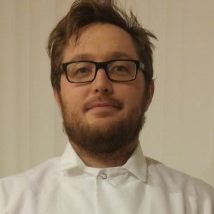
Characterization of Dust on Solar Devices in Southern Nevada
Authors – Jason Sylva and Spencer Steinberg; University of Nevada, Las Vegas
Read Abstract
Dust can impact the efficiency of solar energy collection devices and in some arid environments can reduce solar energy efficiency up to 30%. Reducing the impact of dust is critical in the expansion of solar technology throughout regions where solar energy is utilized. Characterization of suspended and settled particulate matter can assist in developing strategies for dust mitigation. With the characterization of suspended and settled particulate in remote, rural and urban environments, more informed decisions can be made regarding the selection of coating material on solar panels as well as developing cleaning and maintenance procedures. Particulate matter that deposits on a solar surface can potentially interact with solar radiation, precipitation or even directly with the surface material itself. These interactions could lead to the formation of coatings that reduce/block radiation and/or degrade the integrity of the surface. Preliminary characterization of dust can play a vital role when planning the construction of a solar energy facility.
A variety of sampling techniques were employed to obtain particulate matter for characterization. These included direct collection of particulates from solar surfaces: via vacuum and wipe sample collection on panels, tacky dot adhesive slides and plain slides that were exposed for at different intervals, desert vugs that are natural particulate collectors, as well as high volume air sampling for collection of suspended particulates. The sampling methodology allowed for the collection of samples for analyses using various analytical methods that included Raman microspectroscopy, pyrolysis gas chromatography mass spectrometry, ion chromatography and inductively coupled plasma atomic emission spectrometry. These various methods allow for identification of organic and inorganic components as well the mineral distribution of suspended and settled particulate material.

A Survey on IoT Communication and Computation Frameworks
Authors – Shahab Tayeb and Shahram Latifi; University of Nevada, Las Vegas
Read Abstract
This poster surveys fog computing and embedded systems platforms as the building blocks of Internet of Things (IoT). Many concepts around IoT architectures, with various examples, are also discussed. This paper reviews a high-level conceptual layered architecture for IoT from a computational perspective. The architecture incorporates fog computing to address several issues associated with cloud computing; however, it is never a binary decision between fog and cloud. Many of the world’s physical objects are being embedded with sensors and actuators, tied by communication infrastructures, and managed by computational algorithms. IoT sensor networks and embedded systems connecting smart objects are revolutionizing how we approach our daily lives, health care, energy, and transportation. Such computational needs are addressed with an array of various models and frameworks. In an attempt to consolidate the use of these models, this paper reviews the state-of-the-art research in IoT, cloud computing, and fog computing.

Surfactant Effects on Direct Contact Membrane Distillation
Authors – Coral R. Taylor, Pejman Ahmadiannamini, and Sage R. Hiibel; University of Nevada, Reno
Read Abstract
Direct contact membrane distillation (DCMD) is an emerging treatment option for brackish waters and some industrial wastewaters. DCMD utilizes a microporous, hydrophobic membrane that allows water vapor transport while rejecting non-volatile contaminants such as salts and minerals. The driving force is due to the difference in partial vapor pressure across the membrane, generated by the temperature difference between the warm, ‘dirty’ feed water and the cool, distilled product water. Key advantages of DCMD are that it operates at low pressures, can use waste heat or solar heat sources, and maintains efficacy at very high salt concentrations.
The NV Solar Nexus Water Team’s objective is to develop sustainable and advanced water/wastewater approaches to support the water needs of solar energy development. The solar energy industry uses water for both cooling and cleaning; to minimize water use, a DCMD system to treat and reuse solar panel/mirror cleaning water is being investigated. Because membrane hydrophobicity is a key parameter in DCMD performance, the presence of surfactants that are typically utilized during panel/mirror cleaning process may negatively impact the DCMD membrane and produced water quality.
Previous studies investigated the use of DCMD for the solar industry’s water needs; specifically treating on-site groundwater to produce high-quality water for solar panel/mirror cleaning. In this work, a DCMD system is used to treat water with different surfactants at varying concentrations. Establishing a viable surfactant concentration threshold for the DCMD process is significant in that it will provide guidance for solar operators for developing panel/mirror washing protocols. These results will also improve the state of knowledge of the membrane community as well, and will help guide future membrane development with an eye to expanding DCMD applicability to a broader range of waters requiring treatment.
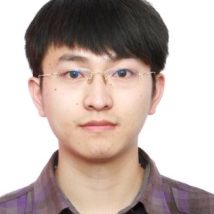
Budget-Based Provisioning Elastic Hybrid Server
Authors – Rui Wu, Jose T. Painumkal, Sergiu Dascalu, and Frederick C. Harris Jr.; University of Nevada, Reno
Read Abstract
To simplify implementation and management of web-based applications, project managers usually choose to rent powerful servers from third party companies. However, in this case, it is rather hard to follow an efficiency plan based on the available budget. In particular, it could be costly when the manager forgets to shut down the servers when not using them, as the related price may become unexpectedly high. Even though some third party companies offer budget notification services, such as Amazon Budgets, it is still difficult to control the usage of the rented servers. In this poster, we propose a modified elastic scale hybrid server method based on the available budget. The servers considered in the paper are called hybrid because they include both owned and rented servers. The proposed method uses queueing theory to dynamically adjust the number of servers. The manager can obtain the approximate queue length and the user waiting time by inputting the budget. Using the proposed method, a prototype system was built to run environmental models. The results show that the proposed approach is better, as it has a lower job waiting time and queue length compared to the traditional FIFO approach. Also, the prototype can shut down the rented servers automatically when they are not being used and can predict both the queue length and the job waiting time.
